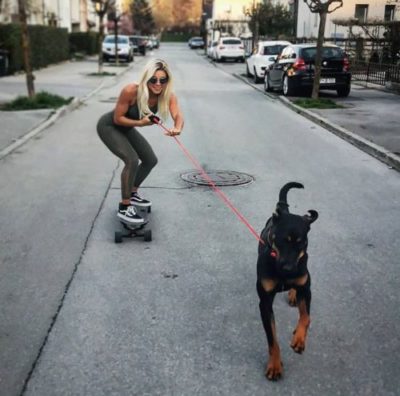
Having a disobedient dog is not a novelty. That is why we train them – to obey our orders and to follow our directions. But what do we do when our beloved pet simply does not react to training? Or, furthermore, what to do when a dog disobeys our leash training?
You’ve come to the right place, because it’s time to share with you how to train your disobedient dog to a leash!
Why dogs disobey their owners?
Since it’s quite hard determining why do some dogs simply do not obey training, all we can do is guess. Most likely, it’s the type of training you expose them to. However, even when you do everything right, introduce your dog to a leash gradually, take the training step by step, some dogs still disobey.
And it’s pretty much down to two options: dogs which pull the leash, or dogs which don’t want to walk on a leash.
So here are our suggestions and some methods which worked for us so far.
Dogs which pull on the leash
A dog or a puppy which pulls on the leash is rather energetic and can’t wait to learn more about the world around them. Though hard to train them to be obedient and to walk happily next to you, it is still completely possible, so don’t worry!
Home training is the key.
Walk your dog around your yard or hallway on a short leash, occasionally commanding “go” or “leg.” It is crucial to stick to one verbal command only and use it repetitively when demanding your dog to obey it.
Once the dog masters one command, you can introduce another one, repeating the process over again.
Tricks to use with dogs which pull
It is also useful to tap yourself on your thigh when you want to indicate to the dog that you want him or her to walk next to you; or even keep a handful of treats in your pocket to reward the dog for obedience. That way you ensure that your dog gradually learns not to walk in front of you, but rather to follow your pace and walk next to your leg.
All this should be done with a short leash which limits the dog’s movement and does not allow him or her to walk away from you.
Once the dog learns to comply with your rules, feel free to gradually lengthen the leash to see how the dog reacts to it. If there is no pulling, reward him with a treat and praise his success and obedience.
Don’t be surprised if pulling starts again any time soon. It simply shows your dog still has to be trained, and that the training is likely to last a bit longer that expected. But, mind you, spending more time with your puppy is a good thing!
In case of pulling, stop the walk and wait for the dog to calm down.
Extra tip: Dogs which pull on the leash are best controlled when their energy level is already down a bit. Slightly tired dogs are more susceptible to training, so use their lack of energy to your advantage and try training them when they are already partially tired.
Dogs which don’t want to walk
Another type of “leash haters” are dogs which simply do not want to walk on a leash. Once unleashed, they start running around, happily playing with other dogs or people around them; but the leash switches it all off, as if the pup transforms from Dr. Jackyll to Mr. Hyde.
Don’t fall into the trap of giving up and taking your puppy home. Your puppy needs all your patience and affection, as the sole reason for its such behavior is fear!
Tricks to use with dogs which don’t walk
Once your dog petrifies, approach him or her, cuddle and caress on the head, and try playing with him or her as if nothing happened, to ensure they relax again.
Try putting the collar and leash once again. If it still doesn’t work, give up for the occasion and go back to practicing leash walking – at home. It is important to repeat the training as many times as possible in familiar surrounding, so that your dog realizes there is nothing to worry about and to nurture their innate curiosity. Always make sure you reward the dog for good behavior with a suitable treat.
If the fear of unfamiliar sounds and smells persists, try familiarizing your dog with the external world more gradually before taking him or her out for regular walks or play sessions in the park. Make those sessions longer; be next to your pup after every new experience; cuddle and reward instances of good behavior and obedience. To make sure the positive reactions are instilled in your pup’s character, always end them with pleasurable moments, be it play or treats which dogs love.
* * *
So there it is, a short and insightful guide to training your disobedient puppy to a leash! Have you tried any of the tips? Have you heard of any others that worked for you? Feel free to share your ideas with us in the comments section below or on our social media!
* * *
And if interested in reading more about dog training, check out our previous posts:

